|
Vintage 1978 Clarion by SEAS
Copyright
2009 © Troels Gravesen

Nils-Åke/Sweden
came by with these 1978 Clarion speakers. "Clarion
by SEAS" the badge says. I have no idea about the
financial set-up behind this speaker brand, but SEAS
seems to have been involved in more than only producing
the drivers.
The speakers that Nils-Åke picked up were in pretty bad
shape. Mid and bass drivers both had rotten foam
surrounds. Bass drivers had new foam surrounds and the
11FMs new rubber surrounds. Fortunately these were
available from Germany: mail@jh-elektronic.de. Website: http://www.jh-elektronic.de/
This speaker is some of the better
vintage stuff - and I like it. The classic
3-way, here from a 10" bass driver (25 F-WBX/DD),
the magnificient 11FM (H130) mid driver, and the
so-and-so 1", H107 tweeter with polyamide dome. I
had my reservations with regard to the dome, but in this
application is does fine with a point of crossover above
5 kHz. Yes, the 11FM runs up to ~5kHz and it does well as
can be seen from the horizontal dispersion graph.
But... before we engage in the new crossover, let's take
a look at the original "Clarion by SEAS,
70120".
To my eyes it's an elegant speaker
with the sloped front panel and matching front grille.
The veneer is excellent and with the narrow front fillets
it makes a nice light-weight appearance; very
Scandinavian and in the best tradition of some Danish
furniture designs (Mogens Kock).
So, what's the big deal here - technically speaking?
Well, we have a small mid-driver handling lower and mid
treble, thus no point of crossover in this most critical
range. Next we have a 1st order filter between bass and
mid because both drivers are close to ideal for such
application. The Clarion was most likely made to be
placed right up against a wall, thus a fairly bright
tuning with a lot of energy in the 1-15 kHz range, way
too much for my taste, even against a wall. The tweeter's
2nd order filter allows it to work much too low and
removing the mid-driver we could still have a decent
two-way system.
The cabinet is made from rather thin chip-board with no
bracing and I wouldn't call it a boom-box, but it is
fairly resonant and could do with some bracing and
bitumen pads.
The bass driver really has a too high Qt for bass-reflex
application and not even a closed box seems ideal unless
we give it 120 liters. In a vented situation the box
could do with some extra 10 liters, providing a few extra
low-end Hz. The graph on the badge is not all wrong in
suggesting an early roll-off below 50-55 Hz. However, the
bass is speedy and punchy and due to the overall
liveliness, we tend to forgive a few low-end Hz missing.
A transmission line cabinet might be ideal for this bass
driver, but here we go with the vented option and will
try to make the best of it.
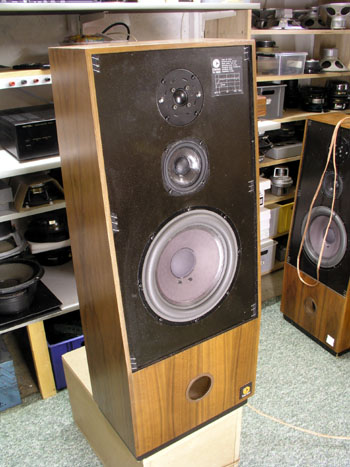 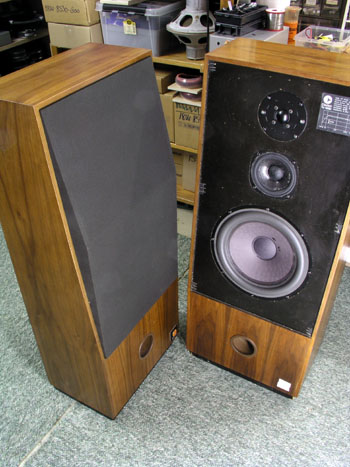
Listening to the Clarion leaves no doubt
that much of the energy is coming from the big 10"
bass driver, or rather mid-bass driver because it makes a
significant impact on the overall frequency range all up
to 3-4 kHz. With the modded crossover, it did't take long
before the speaker was lifted some 20 cm to get vocals
free of early floor reflections - and in case you should
ever come across a pair of these speakers - make stands
of 20 cm height and cut a hole in the bottom to get some
extra 10 liter cabinet volume - and a few extra Hz
low-end extension. More on box tuning below.
Download data sheets: 25F-WBX/DD (apparently the
same as 25F-EWX/DD) and H107. Sorry, cannot
find a data sheet on 11FM. The 25F-WBX/DD data seems a
bit optimistic with regard to sensitivity!
Crossover as-is
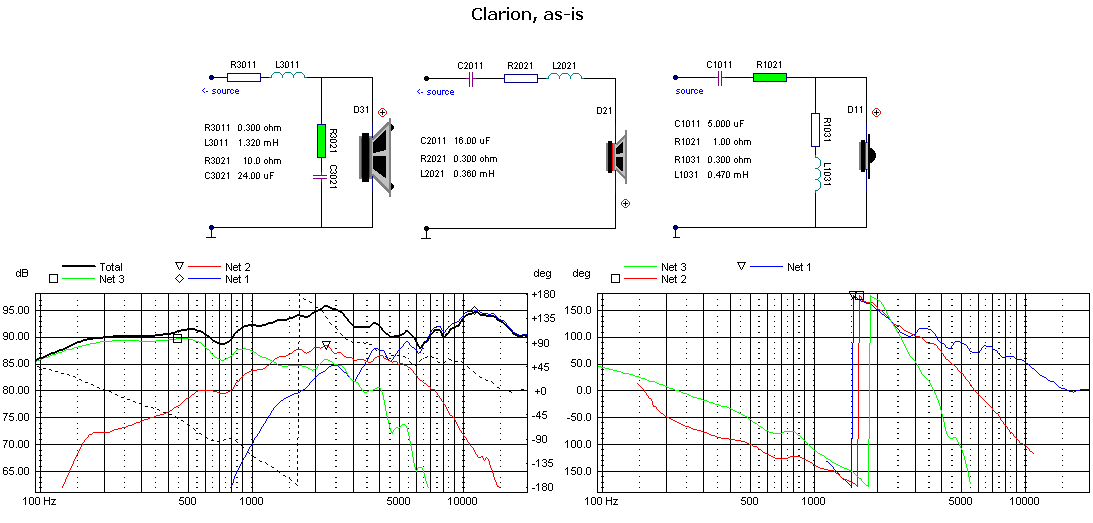
Left: Predicted response of drivers and summed response
from original crossover. Fairly close to what was
measured.
Right: Phase tracking is not bad at all, but the 5-6 dB
peak at 2.3 kHz is hard to ignore. Vocals, brass,
violins, etc., are much too bright.
The mid-driver has a small plastic tube for cabinet and
it's anything but ideal.
A larger mid cab and getting rid of the 180 Hz point of
resonance by proper crossover might do well.
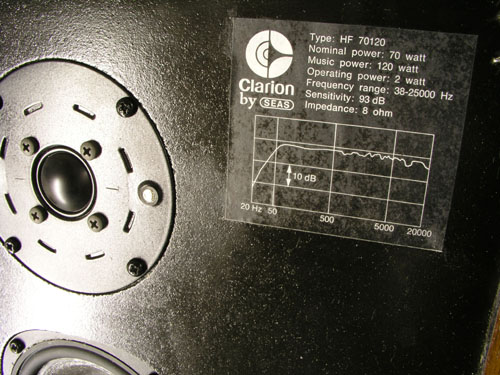 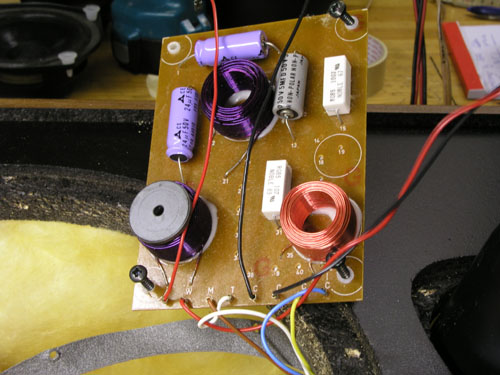
Left: Speaker badge with a quite optimistic 38 Hz low-end
extension and 93 dB sensitivity. The efficiency of the
bass driver is 89 dB/1 watt and we need decent roomgain
to reach a 93 dB sensitivity. But the Clarion claims are
not much worse than anything seen today.
Right: Original crossover on PCB board.
Measurements, as-is
 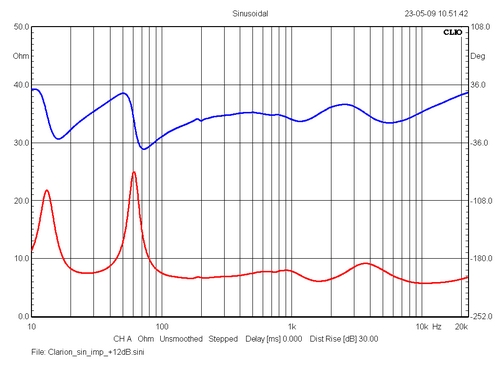
Left: Red is measured response @ 1 meter, 2.8 volts,
exactly as prediced ny LspCAD. Blue is response from new
crossover.
Right: Impedance from original crossover. Indeed an easy
load!
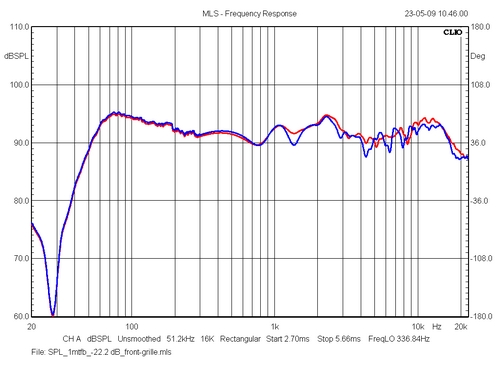
Speaker as-is with (blue) and without (red) front grille.
SPL merged at 300 Hz with bass nearfield response.
Overall the front grille has little impact on performance
- well in accordance with what I heard from the speaker.
The Cabinet
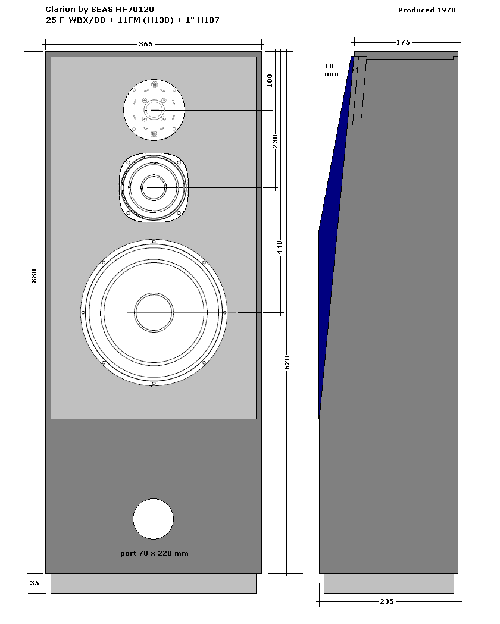
Click image to view large.
25 F-WBX/DD TS data
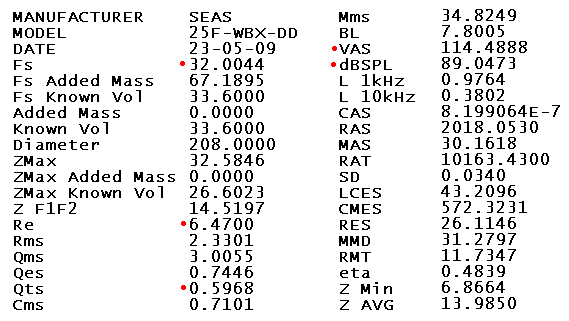
Box simulation:
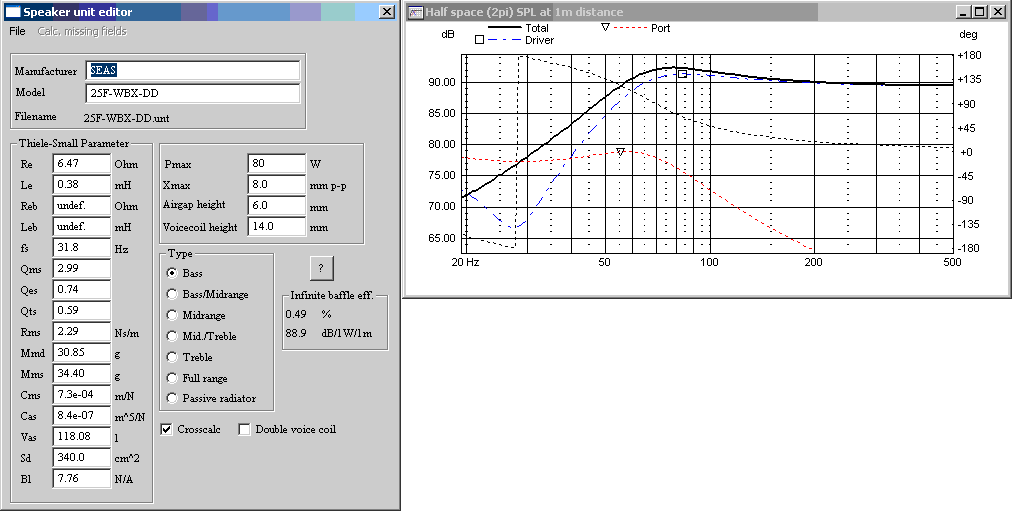
Cross calculation of TS data is pretty spot on. Mms = 34
grams and efficiency = 89 dB/1watt/1 meter.
Calculating the box volume is a bit tricky as the
thickness of panels is not know. From Fb and vent
dimensions, the volume
appears to be 40 liters. However, if panels are 16 mm,
the volume is closer to 50 liters.
My guess is that panels of various thickness was used and
volume is around 45 liters and vent tuning = 26-27 Hz.
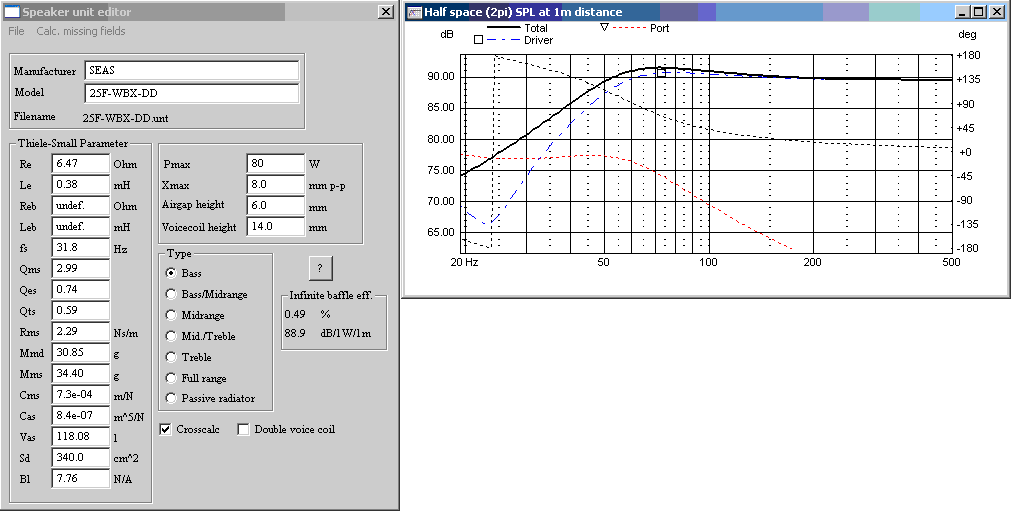
Extending cabinet height with 22 cm at bottom will
increase volume to ~58 liters and F3 is lowered some 5
Hz. Not insignificant!
The added volume could be made like a stand and the vent
could be at the bottom for maximum roomgain. Spikes or
similar of min. 30 mm
height will have to be added. This will bring the 25F
driver to optimum height. Port dim: 70 x 150 mm or 80 x
210 mm for Fb = 27 Hz.
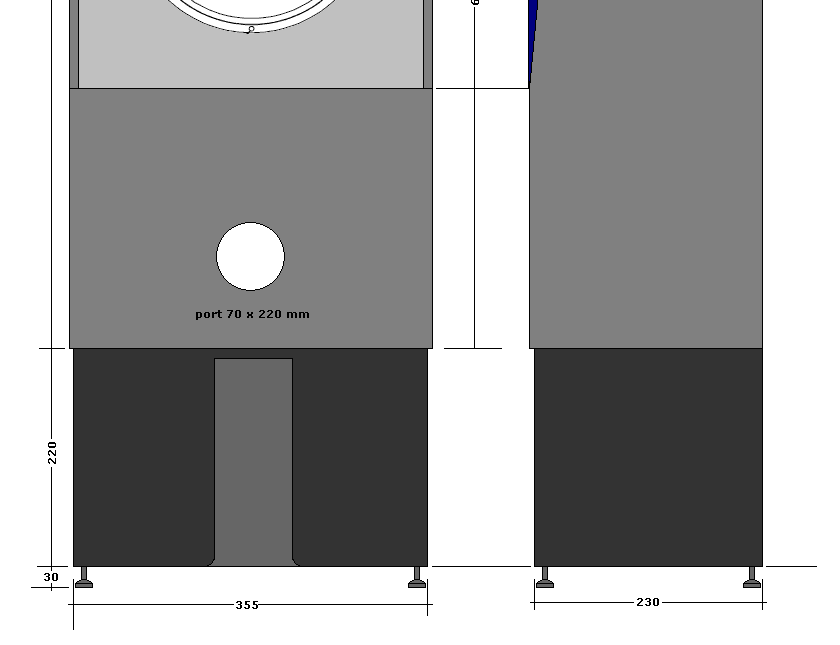
New crossover
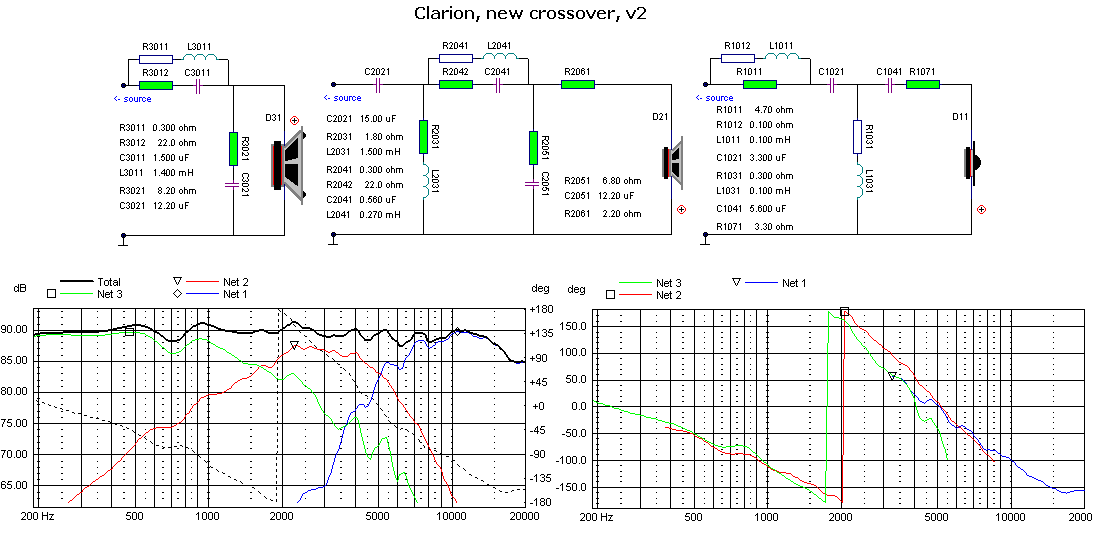
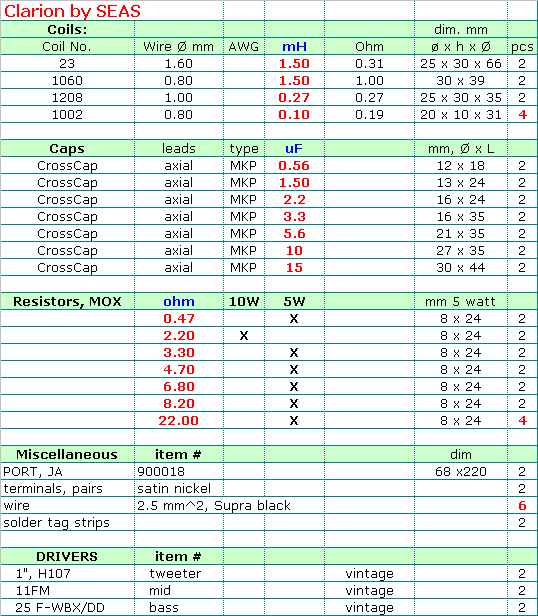
Crossover parts needed for total renovation.
Speaker badly needs new terminals and not least wires.
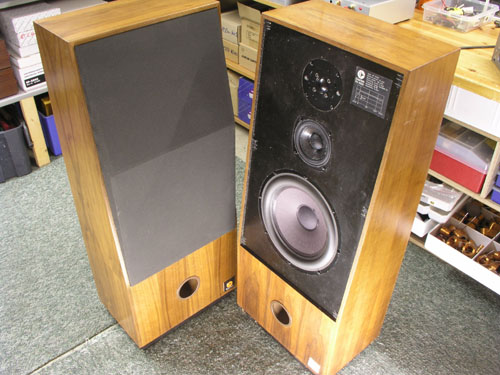 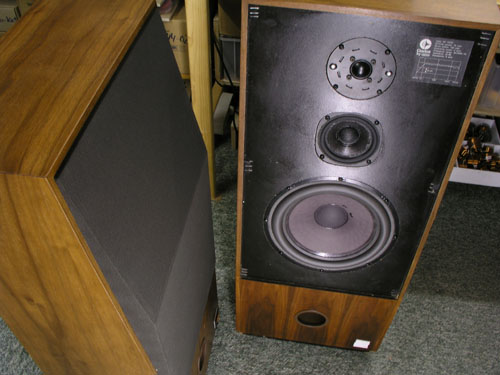
Measurements, new crossover
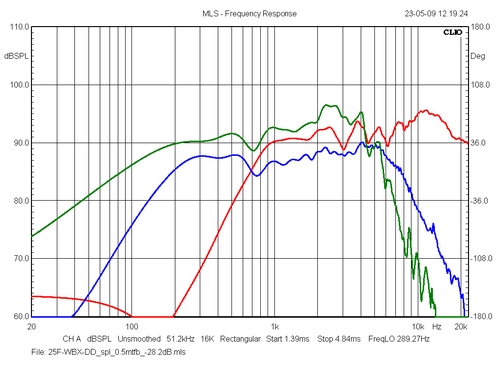 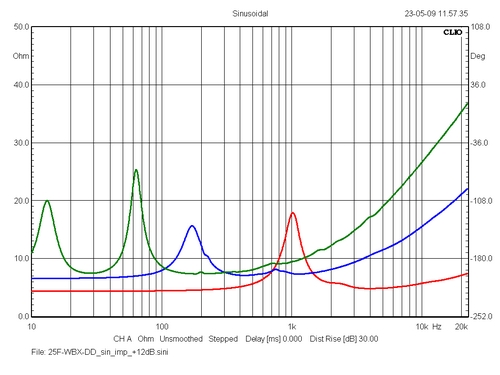
Left: Individual response of drivers mounted in cabinet
with no crossover attached.
The somewhat rugged response from the tweeter is most
like due to nearby cabinet edges.
Right: Impedance of drivers mounted in canbinet.
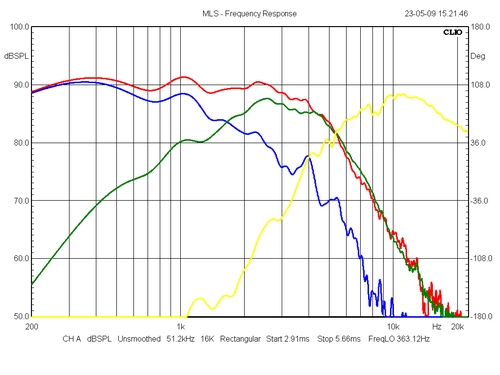 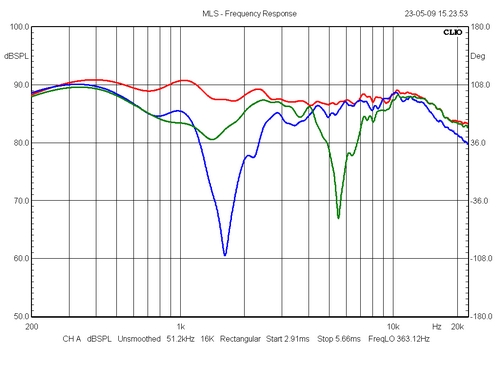
Left: Response of driver driven from new crossover. Red =
summed response of bass and mid.
Right: Green = reverse mid polarity measured between mid
and tweeter height.
Blue = reverse mid polarity measured between bass and mid
height.
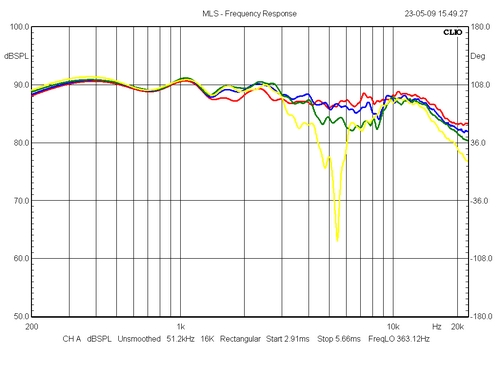 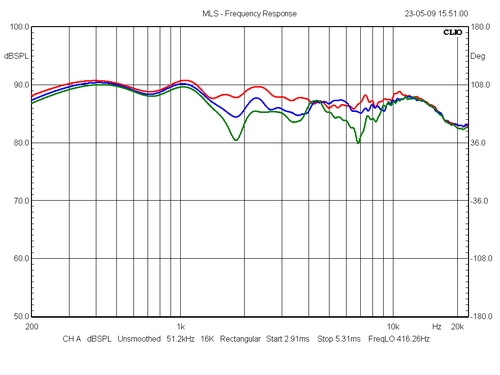
Left: Vertical dispersion measured at 1 meter distance
from mid height and down below bass driver.
Right: Vertical dispersion measured from mid height and
up above tweeter.
Considering the shallow sloped filters used, this is
excellent performance.
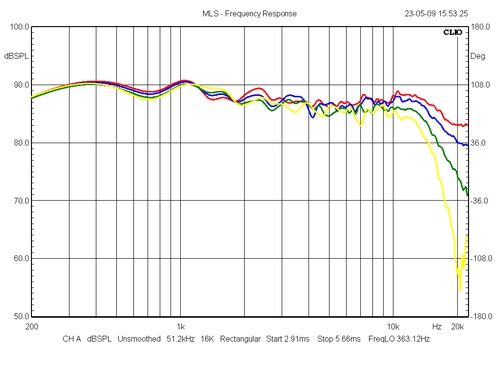 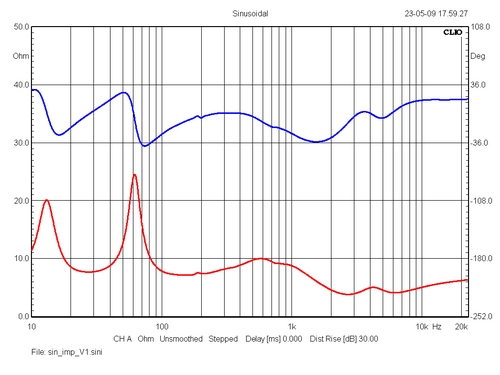
Left: Horizontal dispersion @ 0, 10, 20 and 30 deg.
An even power response over a wide listening area dispite
a high point of crossover between mid and tweeter.
Right: System impedance from new crossover.
Crossover for 27TFFC tweeter
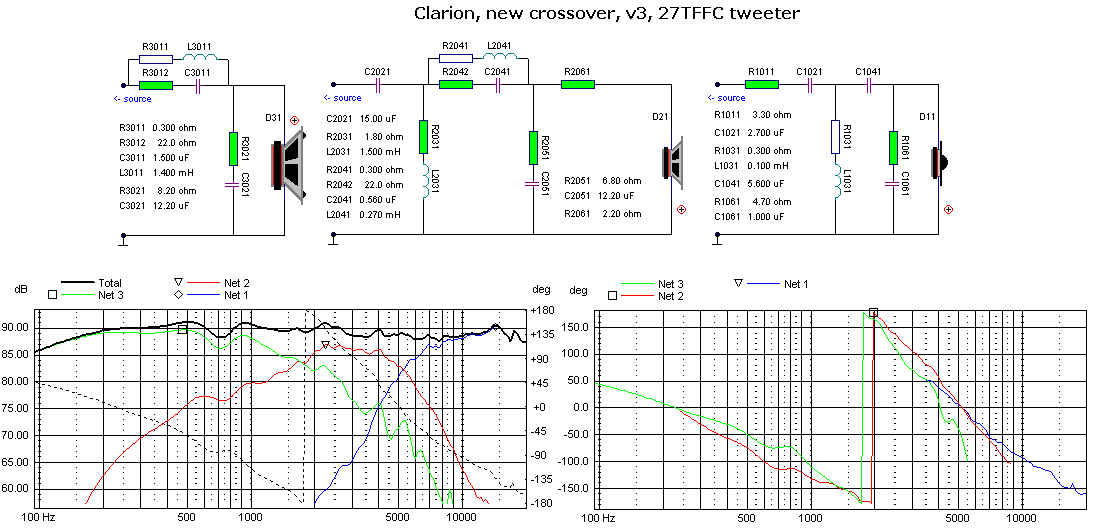
If you really do not believe in the old H107 tweeter,
here's an option for SEAS 27TFFC tweeter.
BTW....
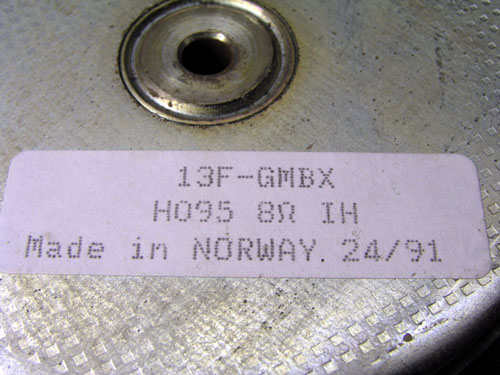 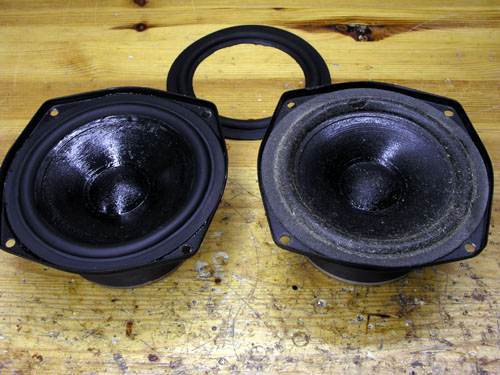
Nils-Åke brought a pair of foam-rotten old 13F-GMBX
drivers. Made in June 1991.
Had a pair of rubber surrounds in the drawer and some
coating material - to cover the dust...
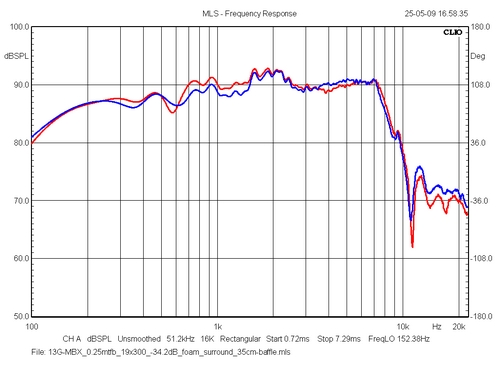
Blue = SPL/1m/2.8V on 30 cm baffle. Red = same driver
with rubber surround. Not too bad.
These midbass drivers may suit my 13" 33FWK-A SEAS
bass units for a MEGA-3W-Classic - some day...
The 13F-GMBX midbass driver is one of the most smooth
sounding drivers I've had.
If I had to pick a driver for a BBC LS3/5a clone, this
driver would be the one.
On a narrow baffle we might accomplish a 84 dB system
sensitivity.
|





















